Months ago, AMD released Ryzen 7, followed by Ryzen 5. From most indications in the market, AMD Ryzen has been a relative success. AMD’s recipe has been simple: offer more cores than Intel even if it means losing a bit of performance per core. Today we have the Ryzen 3 launch, AMD’s assault on the low-end. Two parts are in the initial Ryzen 3 salvo, the AMD Ryzen 3 1300X and AMD Ryzen 3 1200. Both are 65W TDP four core parts that AMD removes SMT for so they are quad thread parts as well. The former has a 3.5GHz base clock with a 3.7GHz turbo and the latter has a 3.1GHz base with a 3.4GHz turbo. Prices are $129 and $109 respectively, and we are going to discuss that in a moment.
Why it is bad practice to compare CPU prices alone
Before we start this section, we are going to have our value comparison charts as normal. We get requests for those at every CPU launch. The Ryzen 3 parts are the equivalent to the Intel Xeon Bronze series in the server world. They are essential parts that allow you to light a platform investing in a bare minimum amount of CPU. In the server world, these parts serve an important function, lowering total system costs for applications such as storage servers that are mostly I/O bound. For desktops, the role is to provide an absolute entry price point to make computing more accessible. Our take is that for most STH readers, the AMD Ryzen 5 1400, Ryzen 5 1600 or Ryzen 7 1700 are better investments.
In our initial Ryzen value piece we included coolers as a $40 value. So for parts that did not come with a cooler, we added $40 in our cores x clocks/ price heat map. We are going to do the same here as spending $109 on a CPU and $109 on an AIO water cooler would be silly. Luckily, the Ryzen 3 parts come with an AMD Wraith Stealth cooler which is perfectly capable if not utilitarian.

If you remember the Ryzen 5 1600 piece where we declared that was the Ryzen 5 to get and likewise with the Ryzen 7 1700, you can see why in the above.
That was using list pricing at launch but chips like the Ryzen 7 1700X have dropped in price by a massive amount (25%) in just the first few months post-launch. Here is what happens when we take Amazon retail pricing as of 27 July 2017:

Here again, you will notice the Ryzen 7 1700, Ryzen 5 1600 and Ryzen 3 1200 are the best value, but that is taking an extremely narrow view. While the difference between the Ryzen 3 1200 and Ryzen 5 1600 parts may seem like 92%, it is still only a nominal $100. The minimum to get a functioning system with 8GB RAM a motherboard, case, PSU, SSD and GPU is likely around $400. In essence, the difference between the 3 1200 and 5 1600, is really only 20% not 92%.
While the above charts are useful for spotting pricing trends and methodologies, our suggestion is to get the Ryzen 5 1600 if you can afford to spend $100 more as you essentially get 2x the performance on a $600 system over a $500 system.
Further, comparing Intel to AMD in the Ryzen 3 range is very difficult. If you simply want the lowest power and cost system, the Intel Core i3 has an ace up its sleeve with an integrated GPU. Essentially, Ryzen 3 parts are not suitable for the lowest cost PCs one can buy because they require the addition of a PCIe GPU. Even a meager PCIe x1 GPU will cost $40 and add to total system power consumption.
Test Configuration
We are going to use the same test bed we used for our Ryzen 7 and 5 reviews. While the motherboard may make sense with the Ryzen 3.
- CPUs: AMD Ryzen 3 1300X and 1200
- Motherboard: ASUS Prime B350-Plus
- RAM: 16GB (4 x 16GB) DDR4-2666
- Boot Media: Intel DC S3710 400GB
- Cooling: AMD Wraith Stealth (bundled)
- Operating System: Ubuntu 14.04 LTS with Kernel 4.10.1
We expect most Ryzen 3 1400 users will opt for a B350 or lower motherboard. When you are running a server-oriented OS, there is very little reason to splurge on a $200 motherboard. The one item we wish the ASUS Prime B350-Plus had was an Intel 1GbE NIC to make OS installations easier.
The AMD Ryzen 3 series also comes with a bundled AMD Wraith Stealth cooler. This is a lower-end and lower-performance cooler than the Wraith Spire that comes with many other Ryzen 5 and 7 SKUs.
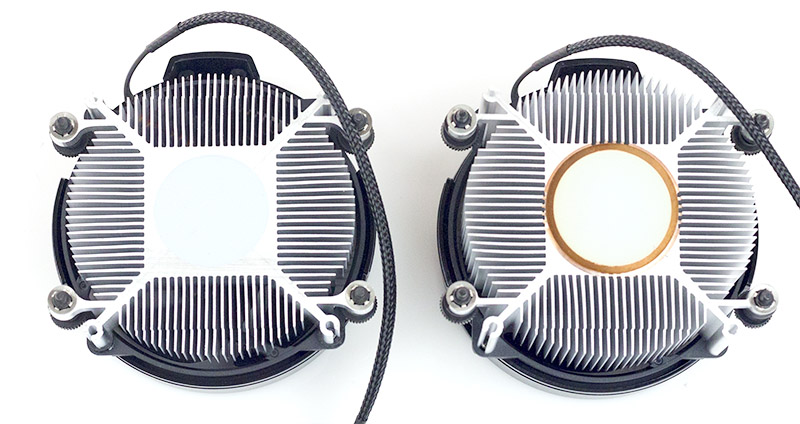
We recommend using Ryzen only with Linux kernels 4.10 and later. Here is the Ubuntu 16.04/ 14.04 upgrade guide but if you are running Debian, RHEL, or CentOS 7 you will need to upgrade to a newer kernel ASAP. Here is the guide to stop the crashes in CentOS 7 by upgrading the kernel to 4.10.1 there. Newer OSes such as Ubuntu 17.04 “Zesty” work out of the box with AMD Ryzen. If you need an LTS release, be sure to check and upgrade your kernel.
AMD Ryzen 3 1300X and 1300 Linux Benchmarks
For our testing we are using Linux-Bench scripts which help us see cross platform “least common denominator” results. We are using gcc due to its ubiquity as a default compiler. One can see details of each benchmark here.
The item to remember here is that any benchmark we are publishing has had at least 10,000 profiling runs on a multitude of different architectures to ensure we get consistent results before we add it to our repertoire. Normally we go one step further and heat soak every machine at 100% load for 24 hours. On multi-node systems we even use a “sandwich” and controlled temperature and humidity to ensure systems are as close to real-world temperatures as possible. Due to the desktop nature of Ryzen chips, we are going to present our Linux kernel 4.10.1 based results all with 24-hour heat soak but with no adjoining systems.
Python Linux 4.4.2 Kernel Compile Benchmark
This is one of the most requested benchmarks for STH over the past few years. The task was simple, we have a standard configuration file, the Linux 4.4.2 kernel from kernel.org, and make with every thread in the system. We are expressing results in terms of complies per hour to make the results easier to read.
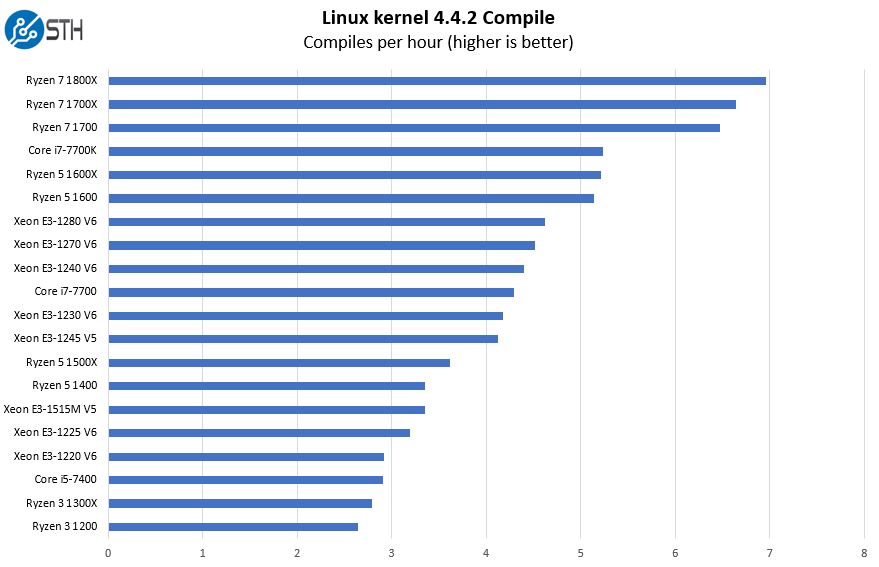
Here we are showing a fairly wide spectrum of CPUs. The new Ryzen 3 chips perform well compared to the Intel Core i5-7400 in this test. Just as a sense of where we are on the spectrum, the quad Intel Xeon Platinum 8180 system we benchmarked was closer to 50 compiles/ hour.
c-ray 1.1 Performance
We have been using c-ray for our performance testing for years now. It is a ray tracing benchmark that is extremely popular to show differences in processors under multi-threaded workloads.
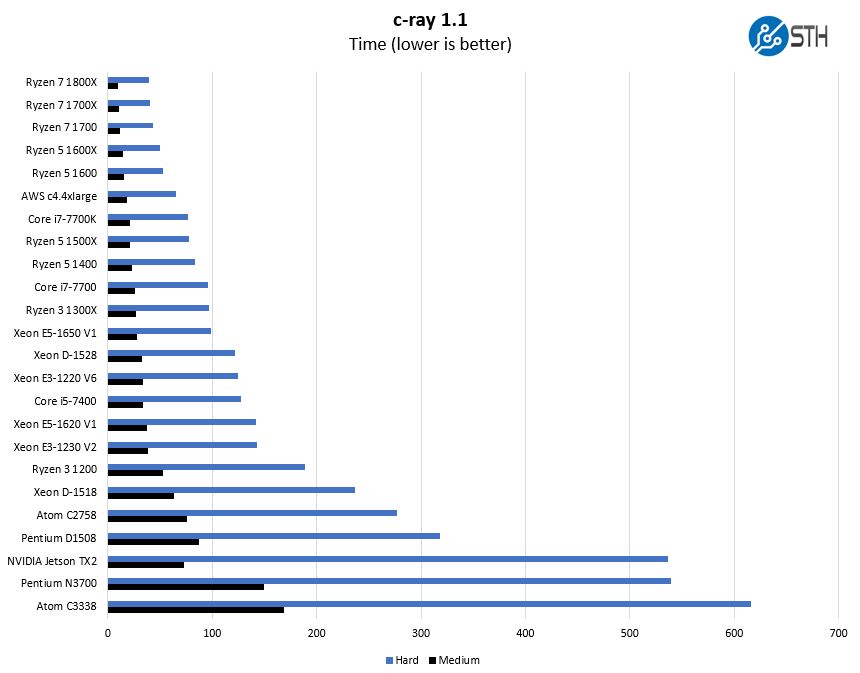
Like Cinebench R15 (that we broke) c-ray is particularly suited to AMD Zen architectures. In this chart we added a nugget, the NVIDIA Jetson TX2 quad core ARMv8 CPU as a reference point to those architectures. In the “lowest cost system for Linux office apps” department, ARM is certainly intriguing.
7-zip Compression Performance
7-zip is a widely used compression/ decompression program that works cross platform. We started using the program during our early days with Windows testing. It is now part of Linux-Bench.
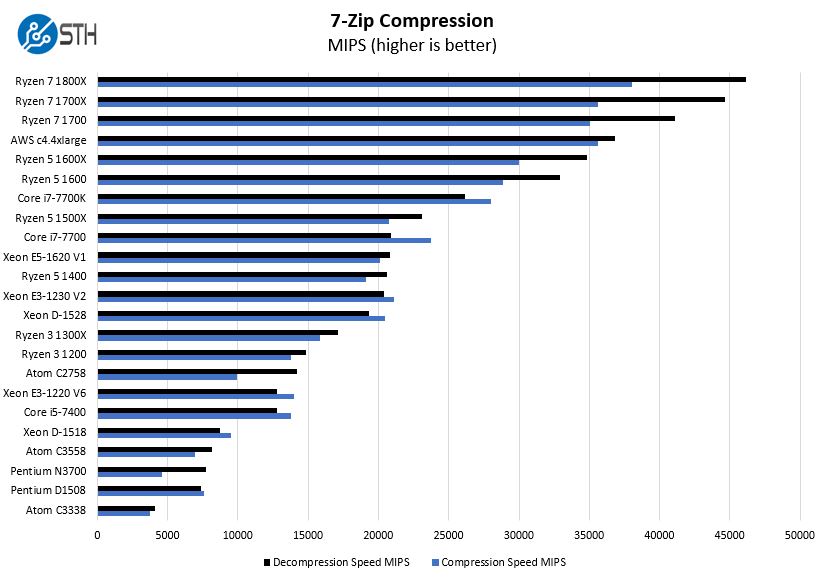
Interestingly enough, here the AMD Ryzen 3 1200 is performing closer to a 2013 era eight core Atom CPU. The key takeaway from this chart is not the legacy Atom. Instead it is the fact that you can essentially get twice the performance for a $100 upgrade to the Ryzen 5 1600.
NAMD Performance
NAMD is a molecular modeling benchmark developed by the Theoretical and Computational Biophysics Group in the Beckman Institute for Advanced Science and Technology at the University of Illinois at Urbana-Champaign. More information on the benchmark can be found here.
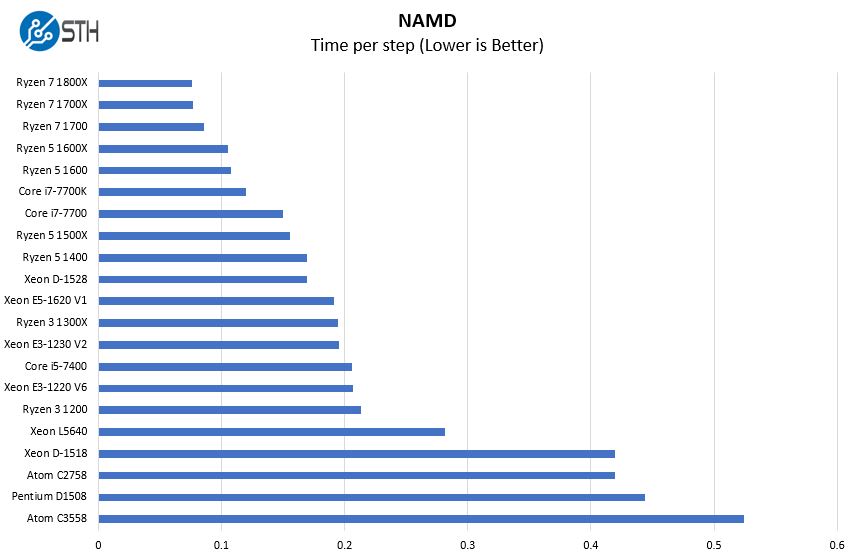
Here you can see that today’s $110 CPU outpaces a 2010 era $1000 CPU with a similar TDP. That is certainly impressive.
Sysbench CPU test
Sysbench is another one of those widely used Linux benchmarks. We specifically are using the CPU test, not the OLTP test that we use for some storage testing.
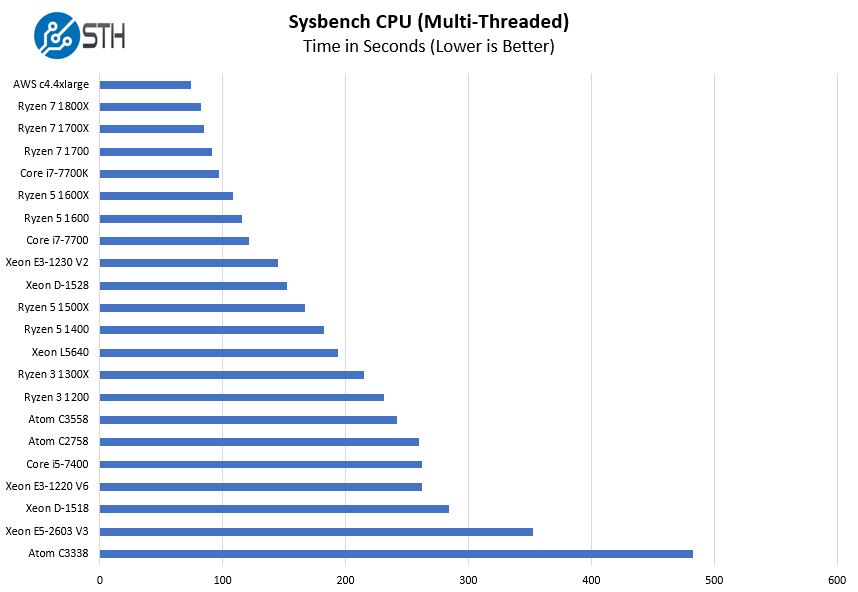
In our previous Ryzen reviews we focused on single threaded performance. Since we essentially know what this frequency of AMD Ryzen CPU will do single threaded performance wise, we are swapping over to multi-threaded. Check one of the previously linked reviews for single-threaded numbers. On this, we did want to highlight the Intel Atom C3558 results. Some of our keen readers may have noticed that they crept into the results table. We have had Intel Atom C3558 results for over 5 months now. We were told there will be no large launch and that they were already “launched” at MWC. While that may be true, you probably cannot buy one if you tried today so take those results, as good as they are, as wishful thinking.
OpenSSL Performance
OpenSSL is widely used to secure communications between servers. This is an important protocol in many server stacks. We first look at our sign tests:
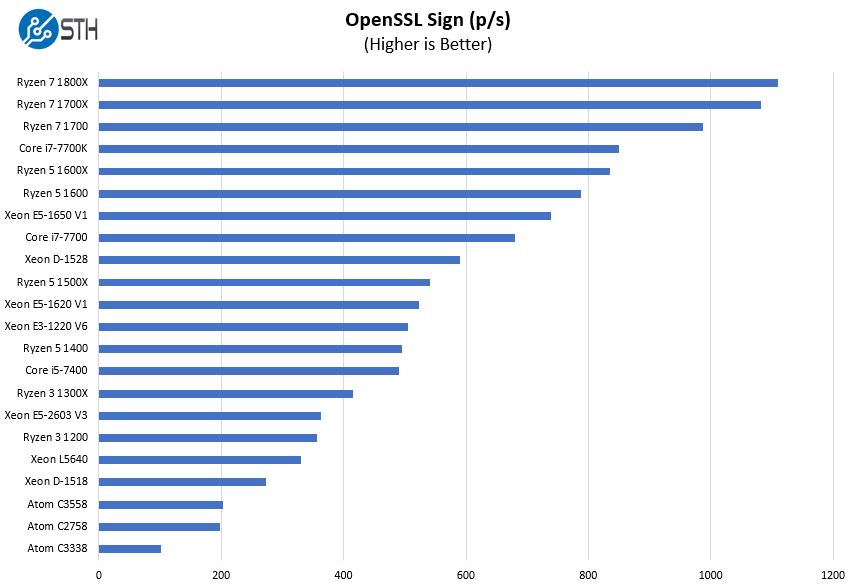
Here are the Verify results:
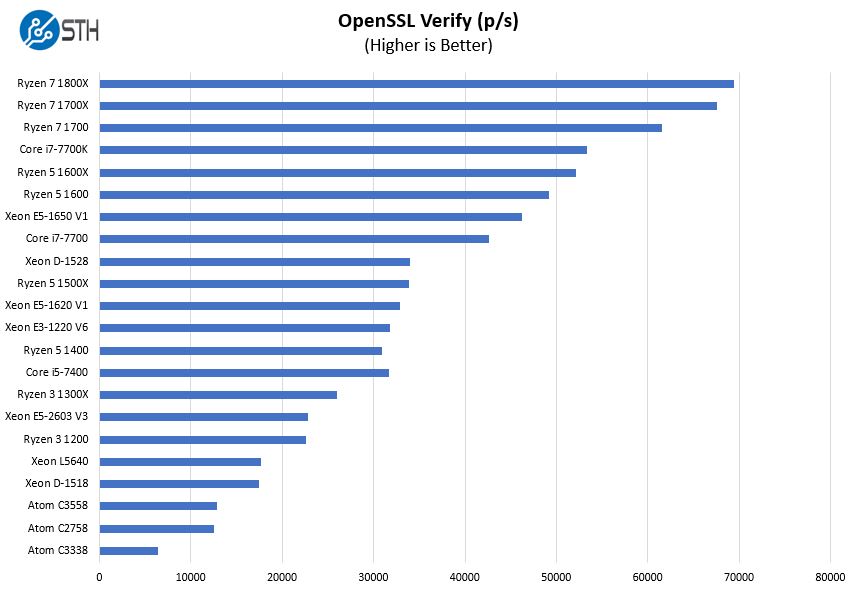
Here you can see solid Ryzen 3 performance, but again, it is hard not to look up the stack. If you were thinking of making a VPN or web server that relied upon OpenSSL, spending $100 more on the Ryzen 5 1600 is what we would do.
UnixBench Dhrystone 2 and Whetstone Benchmarks
One of our longest running tests is the venerable UnixBench 5.1.3 Dhrystone 2 and Whetstone results. They are certainly aging, however, we constantly get requests for them, and many angry notes when we leave them out. For example on our original AMD Ryzen 7 1700X review where UnixBench was crashing due to the kernel version we were using we left the results out and received many e-mails asking about them. UnixBench is widely used so it is a good comparison point.
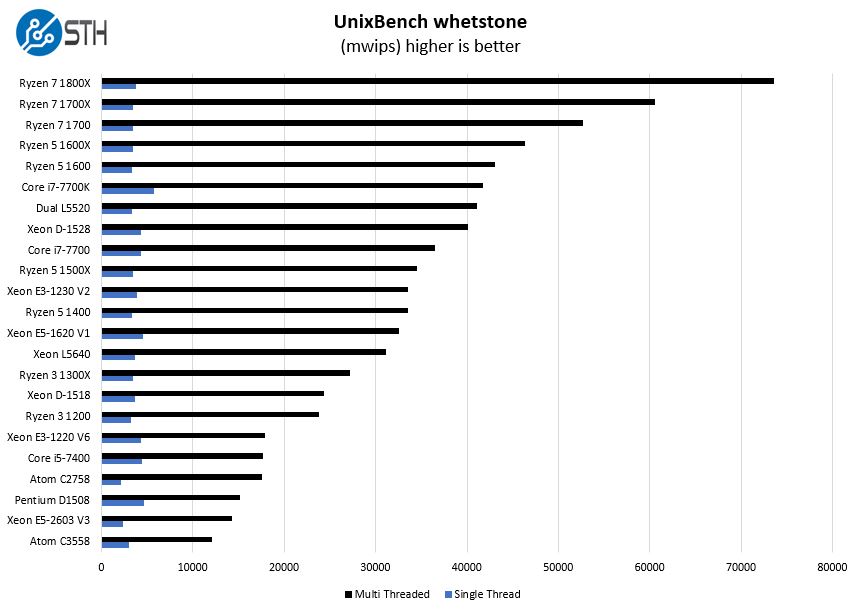
Here AMD with four high clocked threads and a 65w TDP is competing well with the Intel Xeon D-1518, a 35W 4 core/ 8 thread integrated platform design from 2015.
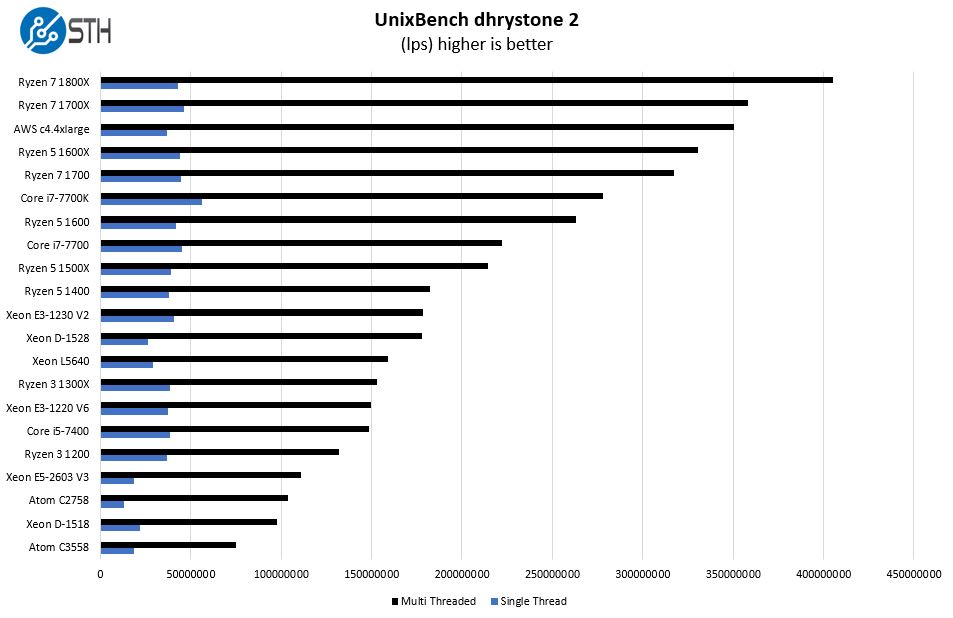
Again, we see solid single threaded performance alongside good multi threaded performance. The Ryzen 3 1300X is extremely competitive with the Core i5-7400 in this test.
Final Words
If one were building a decision tree, an issue is that it gets very hard to lead yourself down the path of the Ryzen 3. While the Ryzen 3 series, on its surface, is a great chip, here is an example of the logic:
- Cheapest/ lowest power x86 office desktop: Core i3 or lower with integrated GPU
- Low-cost gaming machine: Pay 10-20% more ($100) on a system with a Ryzen 5 1600
- Midrange gaming machine: Cost delta between Ryzen 3 and Ryzen 7 1700 is less significant
- Lowest cost non-Intel gaming system: Get a Ryzen 3
To us, the market where one needs a PCIe GPU is above the low-end Core i3 and Core i5 lineup, and therefore the Ryzen 3 lineup. While there will be shoppers in this segment, the fact that AMD is releasing the Ryzen 3 many months after the Ryzen 5 and 7 tells us that this is a product meant for being able to talk market coverage. Surely the APU version of the Ryzen 3 with Vega graphics will be much more interesting.

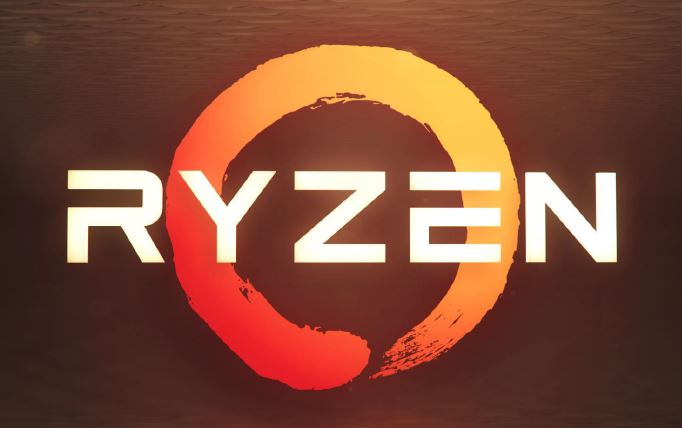



Great article, motivated me to look toward an higher end cpu like the 1600. Thanks.